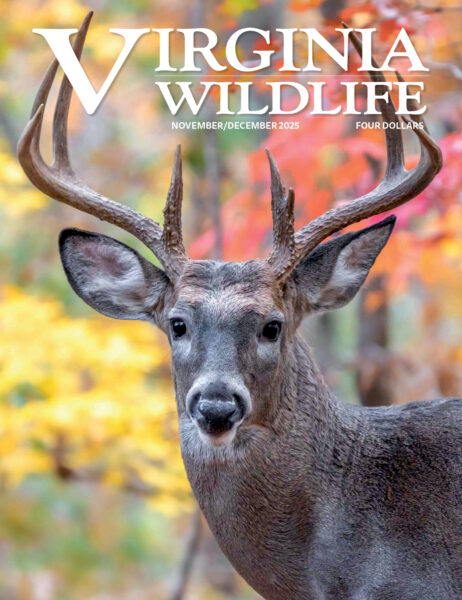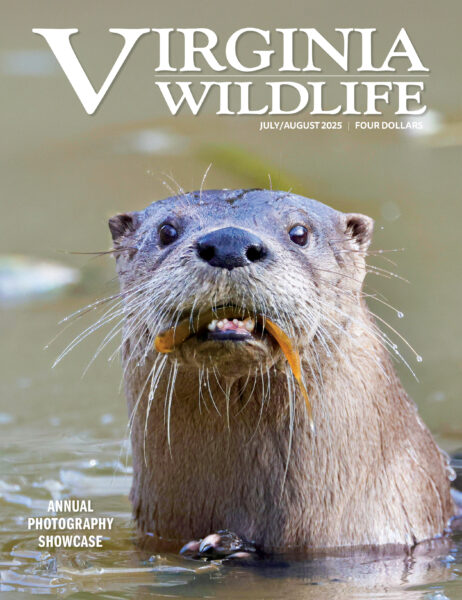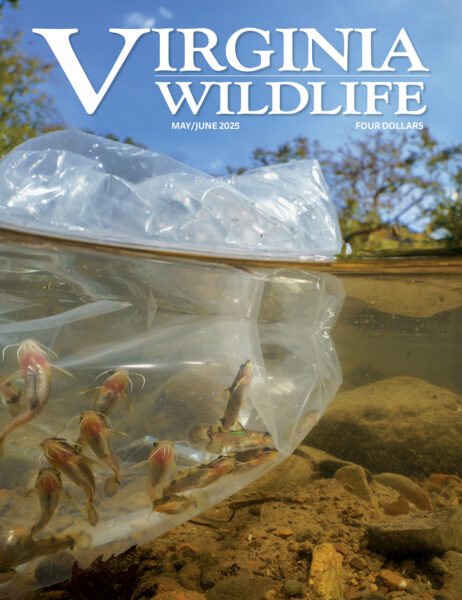The live video stream of a breeding pair of peregrine falcons is entertaining and educational for the public, but also provides valuable data for biologists.
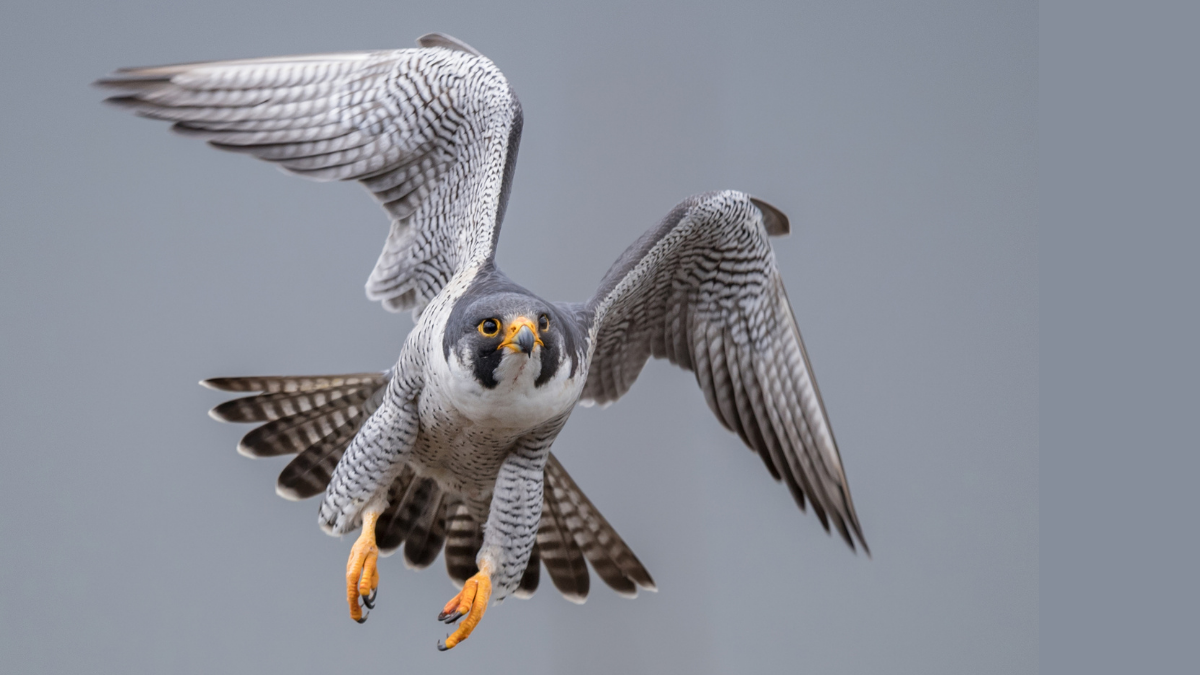
A peregrine falcon, the fastest bird in the world, takes flight, revealing its beautiful plum-age and distinctive markings. Photo by Shutterstock
By Sergio Harding/DWR and Meagan Thomas/DWR
As spring comes to Virginia, the attention of falcon fans turns toward the top of a building in downtown Richmond. There, a video camera live-streams the activities of some unlikely (and unknowing!) reality TV stars—a breeding pair of peregrine falcons (Falco peregrinus)—to an audience made up of thousands of Virginians and fans across the country. “The Richmond Falcon Cam” has for years documented peregrine courtship rituals, territorial disputes, egg laying and hatching, and chick development. Along the way it’s become a popular resource for not only avid wildlife watchers but also teachers and the general public.
We at the Virginia Department of Wildlife Resources (DWR), with technical support from our partners Comcast Business and HDonTap, provide the stream and interpretation of what’s being seen on camera each year. Both the live-stream and corresponding blog posts are available on the DWR website.
Located on a narrow ledge atop the 21st floor of the West Tower of the River-front Plaza building, the camera is fixed on a DWR-built nest box filled with gravel substrate. Over the years, this box has become the focal point of peregrine nesting activity in Richmond.
Once the live-stream begins broadcasting in early March, viewers can bear witness to all the drama of a peregrine falcon nesting season, from wondering if falcons seen in previous years will return to the site to anxiously watching for eggs to be laid, and of course, diligently searching for any signs of “pipping” that indicate an egg is beginning to hatch. When the chicks are between 21 and 32 days old, DWR biologists access the nest site to band them before they fledge (take their first flights from the nest site) just a few weeks later. When the chicks attempt that first flight from the building’s ledge, little do they know they have an audience watching with bated breath and rooting for their success.
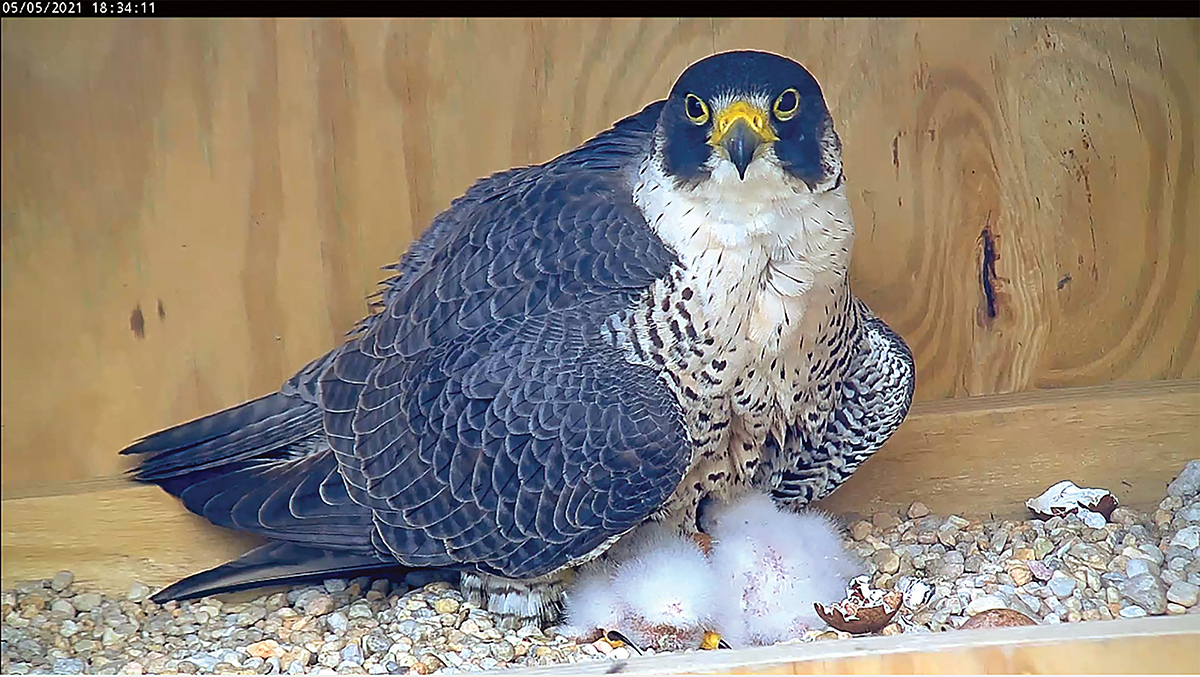
But Falcon Cam fans aren’t the only ones getting wrapped up in the peregrines’ nesting activities year after year. As the DWR biologists involved with Falcon Cam, we also keep a close eye on the birds. We write blog posts for the DWR website explaining falcon behaviors and the major milestones we’ve observed, as well as alerting viewers about what to look for next.
Generally speaking, we provide Falcon Cam as an educational resource for the public, but what you might not realize is that it’s also an important tool for us as biologists as we work to restore peregrine populations to their former glory across the state.
A Species on the Rebound
As the agency charged with the conservation and management of Virginia’s wildlife, one of DWR’s main goals in relation to peregrines is restoring them to their historic breeding range—natural cliff faces of the mountains in the western portion of the state.
The U.S. population of peregrine falcons began a serious decline in the late 1940s due to the impacts of DDT, a type of pesticide that became widely used in agriculture. Toxic residues from DDT in prey species would accumulate in falcons when they consumed these prey. This resulted in abnormally thin eggshells, leading to egg breakage and reproductive failure. Inability to produce young largely contributed to the extinction of the eastern breeding population of peregrine falcons, including Virginia, by the mid-1960s.
Fortunately, pesticide bans and an aggressive reintroduction program that began in the 1970s have enabled peregrine populations to recover. However, due to the small population size and low numbers in the mountains of Virginia, the peregrine falcon remains listed as threatened at the state level.
Peregrine re-introduction efforts in the U.S. took place under the direction of the U.S. Fish and Wildlife Service
(USFWS) through a process called “hacking.” The goal was to release young birds in the hopes that they would recolonize historic nesting sites. Hacking involves relocating chicks old enough to be banded to a protective hack box at the release site. There they are monitored and fed daily for several weeks, until they are able to fly. The birds are then released from the hack box and remain in the area for a period of weeks prior to dispersing. During this time, meals are left out for them until they have learned to hunt on their own.
Early hacking efforts involved captive-bred peregrine chicks. Given the threat of great horned owl predation of peregrines in mountain areas, locations in the Virginia Coastal Plain were deemed safer for hacking of peregrine chicks in the late ’70s and early ’80s. These efforts have resulted in a robust and expanding population of peregrines in the Common-wealth’s coastal areas. Hacking also occurred in the mountains of Virginia in the late ’80s through the early ’90s. After a short hiatus, hacking in the mountains resumed at Shenandoah National Park in 2000, and has taken place there annually using wild-hatched peregrines, mostly originating from nests on coastal Virginia bridges.
Peregrines in Virginia have been slower to resume breeding in the mountains than in the Coastal Plain. However, there are positive signs that they are also making a comeback in the mountains. In 2021, there were 29 documented peregrine nesting sites in Virginia. Of these, five were located in the mountains, an all-time modern high and a promising sign of the continued expansion of the population into its former breeding range.
The Role of the Falcon Cam in Peregrine Conservation
DWR works closely with the Center for Conservation Biology (CCB) at William & Mary and other partners to monitor Virginia’s peregrine falcon population. Collectively, the partners gather information about which sites are being utilized by the approximately 30-plus falcon pairs that have nested around the state in recent years and what the birds’ breeding outcome is for the season. While these data are typically collected through visits to individual sites, the Richmond Falcon Cam is a valuable tool by allowing us to monitor the Richmond pair remotely.
The Falcon Cam also makes it relatively easy for us to identify individual falcons based on their plumage characteristics and/or their leg bands, a task that can be challenging to accomplish in the field. Many states make an effort to band peregrine falcons, which allows biologists to track the movements, lineages, reproductive history, and longevity of individual birds. This is especially important in small falcon populations that are still recovering, as is the case in Virginia. Thanks to these banding efforts, we know the origins of the current Richmond pair.
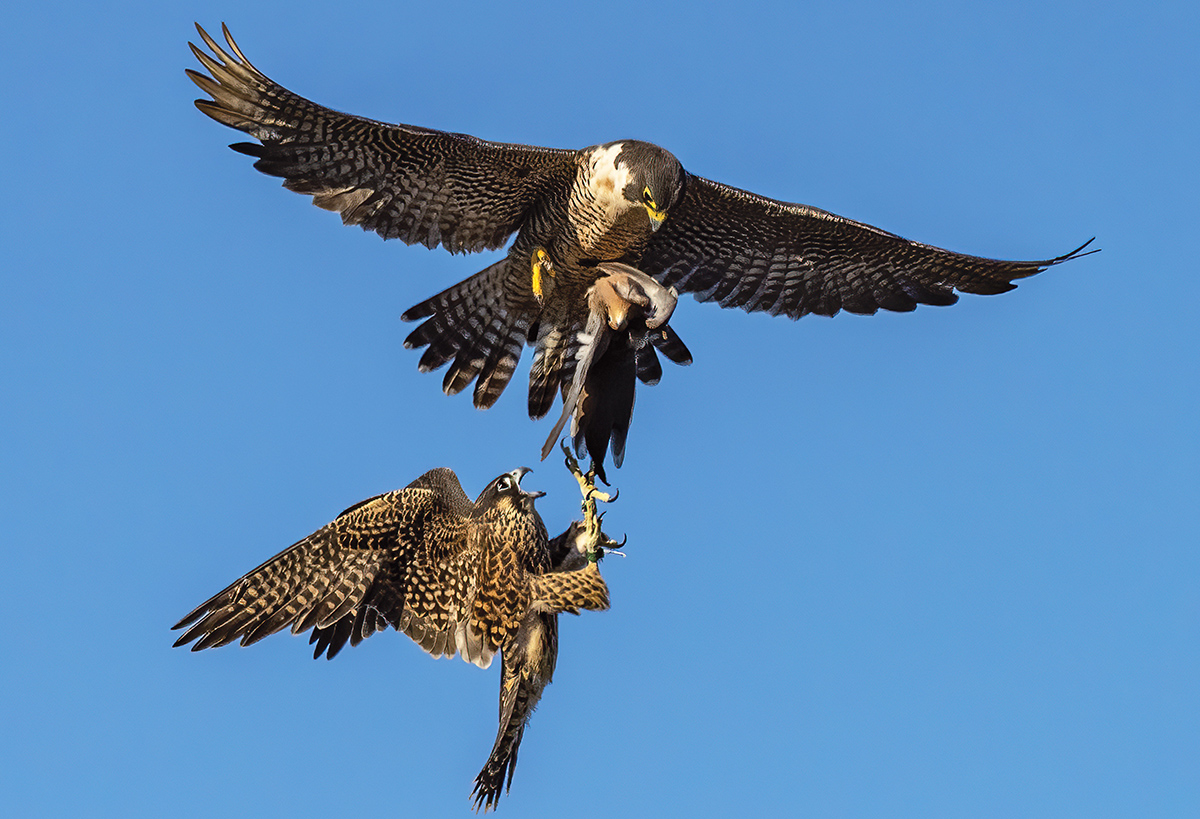
The Richmond site is one of three known urban peregrine nesting sites across the state. Here, a peregrine in Reston delivers a mourning dove to its offspring during an aerial prey exchange. Photo courtesy of Ryan Corey Wildlife
The Falcon Cam has also allowed us to track prey items brought back to the nest site, giving us valuable information on the Richmond pair’s diet that would otherwise be difficult to obtain. Over the years we have observed that yellow-billed cuckoos appear to be a favored prey item, in addition to grackles, starlings, pigeons, and other medium-sized birds. The Richmond pair has also been known to consume rails, a good indicator that they are not only hunting downtown but will also travel some distance down the James River to hunt in marshy areas. And, we’ve documented a few surprising prey items over time, such as a red-headed woodpecker, finches (of note because of their small size), and even a bat that was once brought back to the nest box.
Finally, the Falcon Cam gives us a front-row seat to document details of peregrine behavior that are otherwise difficult to document in the field, especially at mountain sites. There, the remoteness of nests high on cliff faces can make it challenging to detect the birds, which can be up to a mile away from viewing locations. Even with spotting scopes and binoculars, it is incredibly challenging to observe specific behaviors or see the nest tucked into rocky crevices. The Falcon Cam has taught us what to expect from peregrines at different stages of their breeding cycle; we can apply this knowledge to make inferences about the breeding status of pairs at mountain sites, even when our observations of those birds are few and scattered.
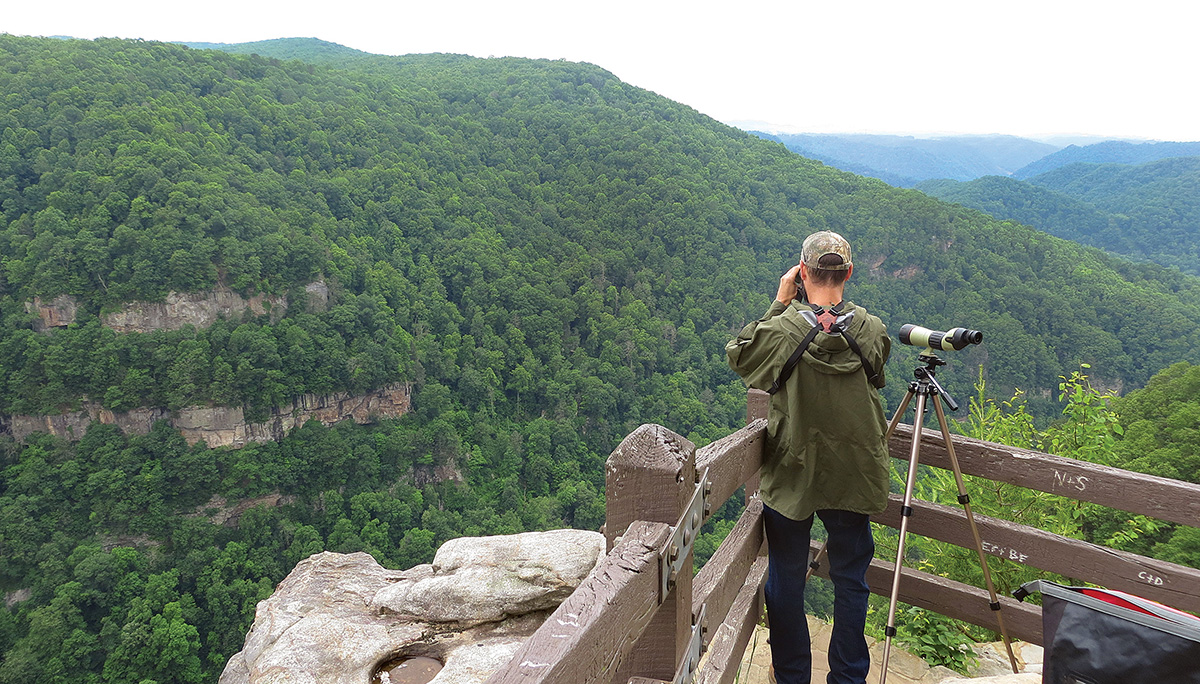
Seth Thompson of DWR conducts a peregrine falcon survey at a natural cliff face in the mountains of Virginia. Photo by Sergio Harding/DWR
Turnover in Richmond
It wasn’t until 2003 that falcons began successfully breeding in Richmond. That original pair of birds consistently nested for over a decade, ultimately producing 36 chicks. However, between 2016 and 2021 we saw a high turnover in individual birds, sometimes within the same season. Peregrines tend to be attracted to particular sites based on the site’s attributes, and different individuals may use the same site across periods that span human generations. Downtown Richmond is one such high quality site given its access to an ample prey base and the building’s height, which gives the peregrines a commanding view of the surrounding landscape.
The arrival of new birds to the established Richmond territory has made for a markedly different viewing experience following those many years of observed stability with the original pair. While Falcon Cam viewers knew what to expect from the original pair, these new birds brought with them new ways of interacting with one another and with their surroundings. This variation in behaviors among individuals has led to many fresh and captivating moments that have played out before the Falcon Cam.
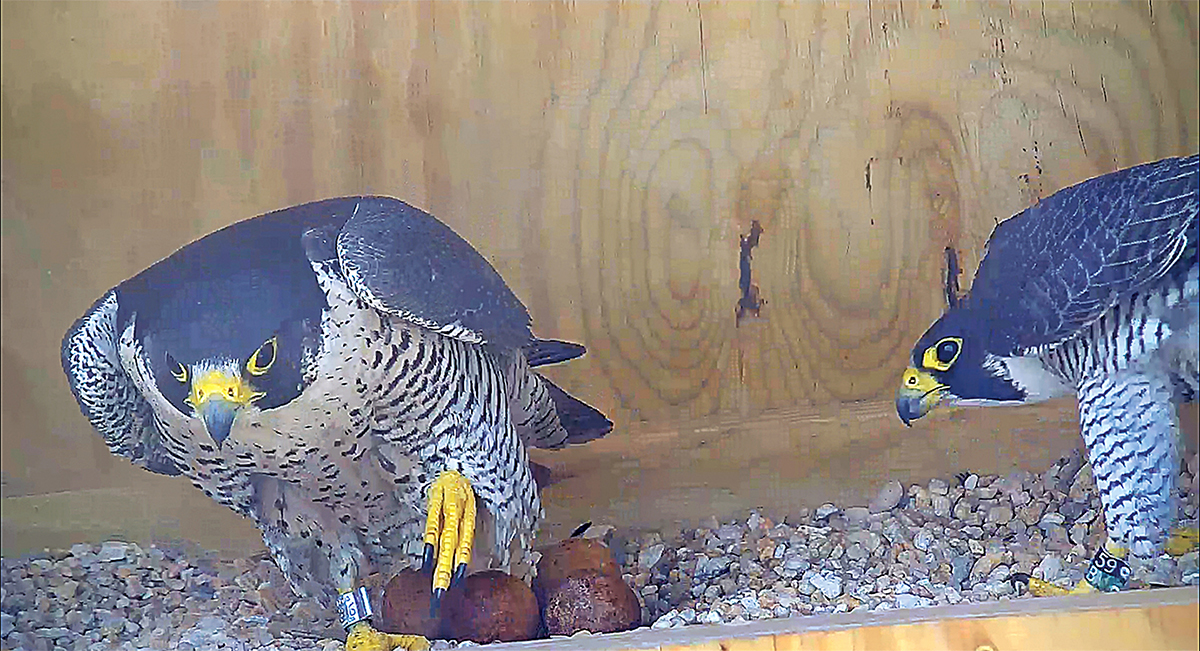
Both the male and female peregrine incubate the eggs, alternating positions throughout the day. Here, the male (left) has returned to the nest for incubation duty, thus temporarily relieving the female.
So who are the birds that have most recently occupied the site?
The Female, 95/AK: Despite a short tenure in Richmond, the current female of the pair (known as 95/AK based on her bands) has already garnered quite a notable reputation among falcon fans. She hatched and fledged from Delaware in 2018 and first appeared on camera in 2019 as a sub-adult female, roughly only a year old. Despite her immaturity, she success-fully ousted an adult female of unknown age that had begun bonding with the male. Although she didn’t produce any eggs that year, likely due to her young age, she continued to hold down the site and was frequently seen on camera.
The female 95/AK returned to Richmond for the 2020 breeding season as a mature adult, displacing another female that had already begun to claim the site. This thrilling, territorial clash was caught on camera and ultimately resulted in 95/AK establishing herself as the new breeding female. In that very same year we got to see 95/AK lay her first clutch of eggs and raise her first chick.
The Male, 59/BM: Last year’s male peregrine (known as 59/BM based on his bands) is also a younger bird. He hatched and fledged from the Yorktown Power Station in 2019 and first appeared on camera in 2021. Fans across the state witnessed his eventually successful attempts to court 95/AK, including the delivery of prey gifts, deep and rapid bows in her presence, and attempts to convince her to join him in the nest box.
Although this male hails from Yorktown, he has ties to Richmond as his mother was the breeding female seen on camera in 2017. After raising chicks that year with the original male, she moved on to a new site in Yorktown, found a new mate, and produced the current Richmond male.
The 2021 season was an incredibly exciting year for Richmond Falcon Cam followers. Not only did viewers get to observe the birds bond as a pair for the first time, they also got to watch them raise and fledge four chicks, a milestone not seen in Richmond since 2007. This feat was all the more impressive considering the breeding pair’s young age and lack of experience.
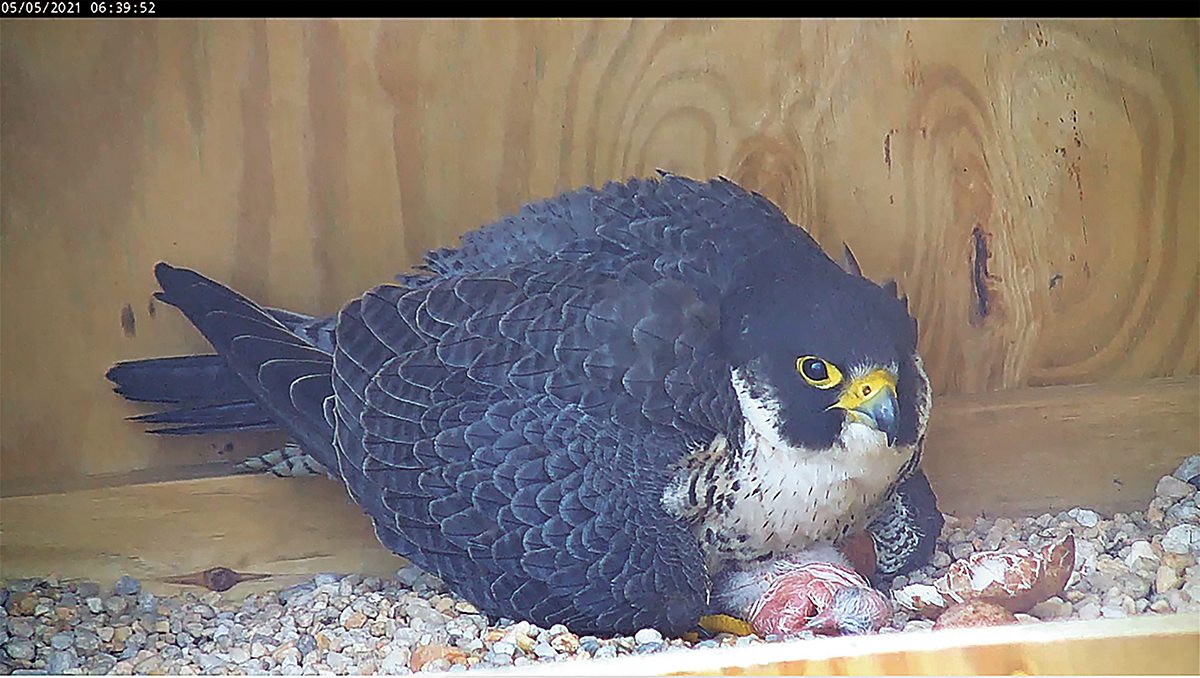
The female of the peregrine pair adjusts her position, revealing her newly hatched chicks. Although the chick’s pink skin is visible immediately after hatching, their down dries quickly, giving them a fluffy, white appearance.
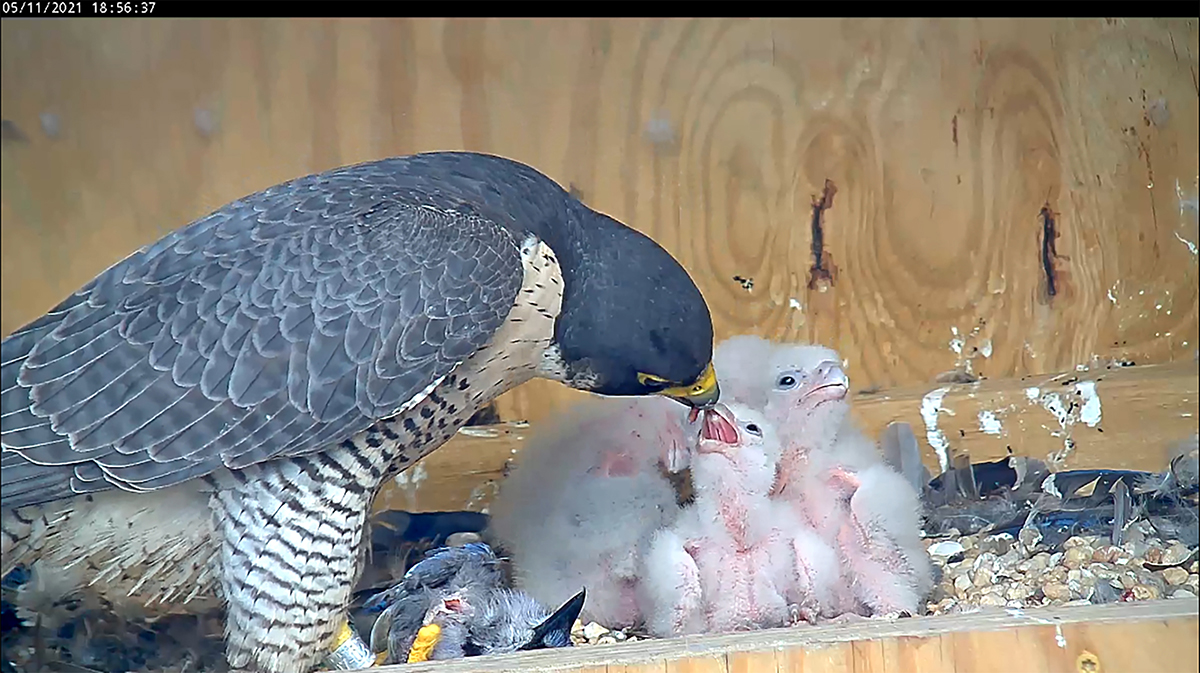
One of the first meals the chicks received consisted of a blue jay that was delicately fed to them.
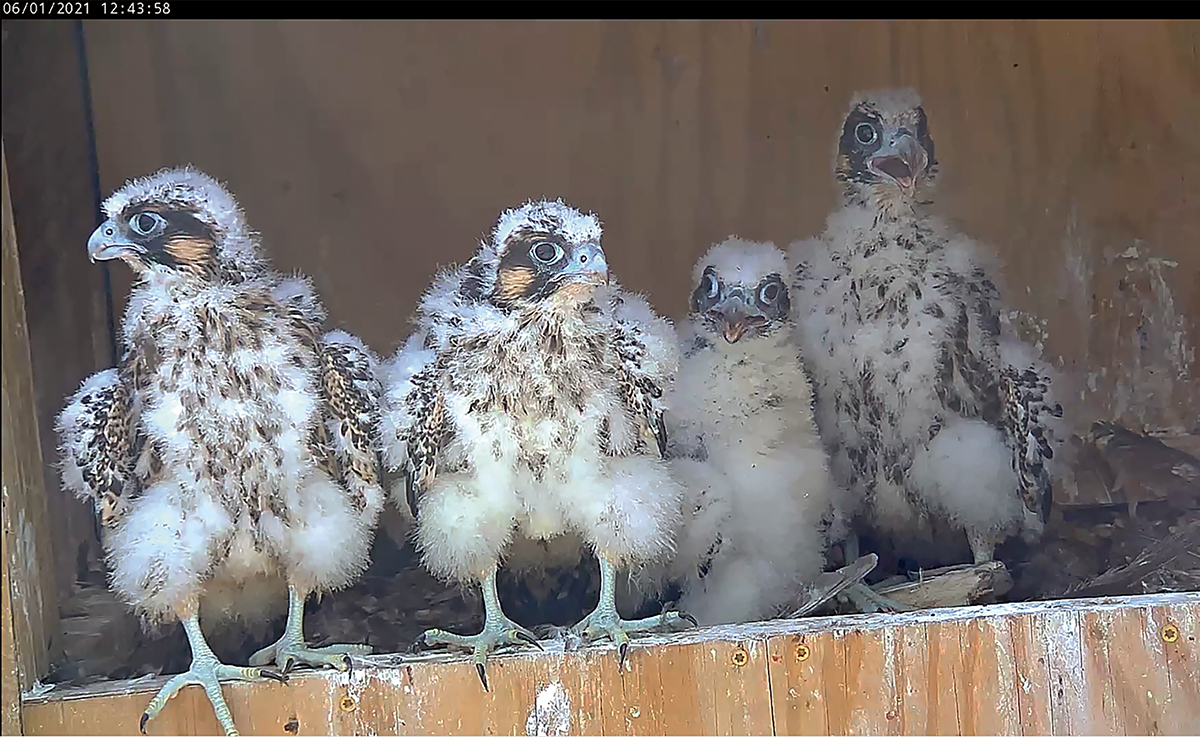
The 2021 chicks, at four weeks old, are capable of leaving the nest box and exploring the surrounding ledge. This photo was captured just two days before they received their bands.
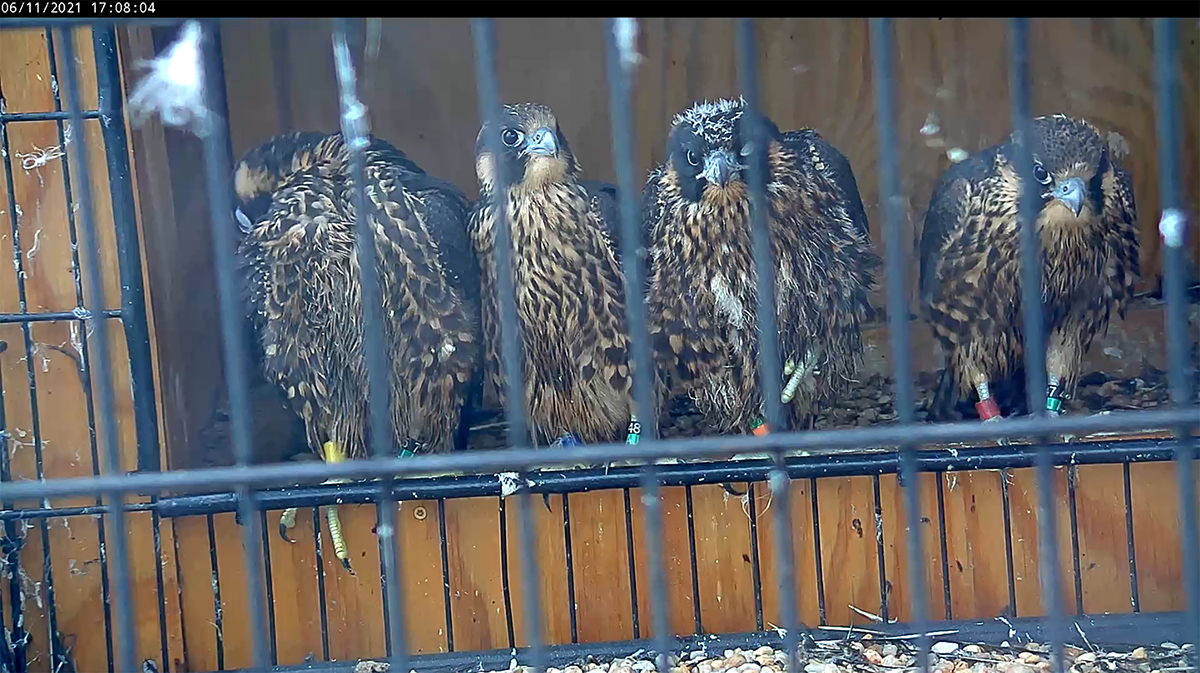
When the chicks are banded, biologists attach colored tape to the bands, which aids in the identification of the chicks after they fledge. This colored tape falls off naturally after a few weeks.
In fact, one of our favorite moments from the 2021 season was witnessing the male’s first interaction with his newly hatched chicks. As biologists, we make a point to not anthropomorphize wildlife, but it is difficult to describe his reaction as anything other than completely befuddled upon first seeing that small, white ball of down.
So what does 2022 have in store for the falcons? Given the relative newness of this pair, we don’t know what to expect.
These birds live a whole other portion of their lives off camera during the non-breeding season. With that in mind, every year starts with a bit of uncertainty. Will a new bird come in and displace one of them, or will we see continuing stability in the pair? How many eggs will be laid, and how many chicks will fledge? The only way to know for sure is to follow along with us in 2022!
Sergio Harding works as a nongame bird conservation biologist with DWR. When he’s not working with peregrines, he enjoys working with loggerhead shrikes, golden-winged warblers, and several other species. Sergio lives in Richmond.
Meagan Thomas is a watchable wildlife biologist with the DWR who resides in Williamsburg. Although she possesses a lifelong passion for wildlife and the outdoors, she has a particular affinity for birds, reptiles, amphibians, and nongame fish. When she isn’t working, she enjoys spending time on the water with her husband and three dogs.

This article originally appeared in Virginia Wildlife Magazine.
For more information-packed articles and award-winning images, subscribe today!
Learn More & Subscribe


